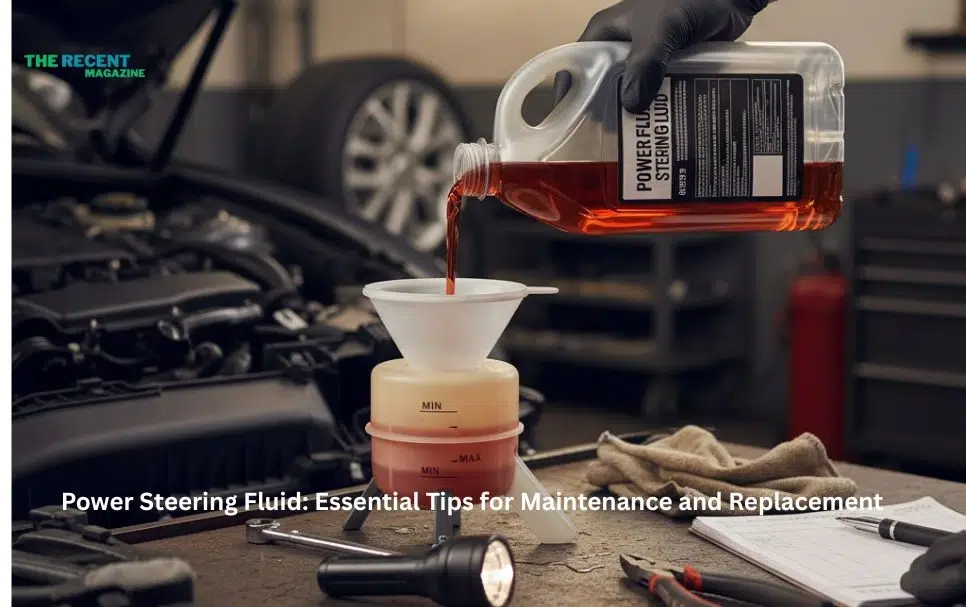Now Reading: Power Steering Fluid: Essential Tips for Maintenance and Replacement
-
01
Power Steering Fluid: Essential Tips for Maintenance and Replacement
Power Steering Fluid: Essential Tips for Maintenance and Replacement

If you want your car’s steering to feel smooth and responsive every time you hit the road, understanding power steering fluid is key. This little-known liquid plays a big role in making your driving experience safer and more comfortable.
But do you know why it matters, when to check it, or how to spot signs that it needs changing? Stick with me, and you’ll discover simple tips to keep your power steering fluid in top shape saving you time, money, and unexpected repairs.
Ready to take control of your ride? Let’s dive in!
Power Steering Fluid Basics
Power steering fluidhelps make steering smooth and easy. It moves through the power steering system to help turn the wheels with less effort. This fluid also protects parts from wear and stops rust and corrosion inside the system.
There are different types of power steering fluid. Some are made for specific car brands or models. Common types include mineral-based, synthetic, and automatic transmission fluid (ATF) used in some systems. Always check your car’s manual to pick the right type.
Signs of low or dirty power steering fluidinclude loud whining noises when turning, stiff steering, and slow response in the wheel. Dark or thick fluid means it is contaminated and needs changing. Regular checks keep your steering safe and smooth.

When To Check And Replace Fluid
Check power steering fluidevery 30,000 to 60,000 miles. This helps keep the steering smooth and safe. Some cars need fluid checks more often, so check your owner’s manual. Signs of low or bad fluid include hard steering, strange noises, or fluid leaks under the car.
Old or dirty fluid can cause pump damageand steering problems. It also makes the steering system work harder, which wastes fuel. Changing the fluid keeps the system clean and working well.
| Recommended Maintenance Intervals | Symptoms Indicating Fluid Issues | Effects of Old or Dirty Fluid |
|---|---|---|
| Check every 30,000-60,000 miles | Hard steering | Pump wear and damage |
| Follow car manual advice | Whining or squealing noises | Steering becomes stiff |
| Top up fluid if low | Fluid leaks under car | Increased fuel use |
Choosing The Right Fluid
Choosing the right power steering fluidmeans following your car’s manufacturer specifications. Use only the type recommended in your vehicle’s manual. This keeps the system working well and prevents damage.
Synthetic fluidslast longer and handle heat better than conventional fluids. But some cars need conventional fluid. Check your car’s needs before buying.
| Type | Pros | Cons |
|---|---|---|
| Synthetic | Better heat resistance, longer life | Usually more expensive, not for all cars |
| Conventional | Cheaper, works for many older cars | Shorter life, less heat resistance |
Fluid compatibility tips:Avoid mixing different types of fluids. Mixing may cause damage or poor performance. Always clean the reservoir before adding new fluid. Replace the fluid regularly for smooth steering.
How To Check Fluid Levels
The power steering fluid reservoiris usually under the hood. It looks like a small, clear tank with a cap.
Check if the reservoir has a dipstickor a sight glass. Dipsticks need to be pulled out to see the fluid level. Sight glasses show the fluid level on the side of the tank.
Always check the fluid when the car is offand cool. Clean the dipstick before checking. Dip it back and pull out to read the level. The fluid should be between the minimumand maximummarks.
Use a clean clothto wipe the dipstick. Add fluid slowly if it is low. Avoid overfilling to prevent leaks and damage.
Step-by-step Fluid Replacement
Tools and materialsinclude a wrench, drain pan, funnel, and new power steering fluid. Use clean rags to wipe spills. Safety gloves help protect your hands.
Start by locating the power steering fluid reservoir. Place the drain pan under the vehicle’s power steering system. Remove the drain plug or disconnect the hose carefully. Let the old fluid drain fully into the pan. Dispose of old fluid properly.
Flushing the system clears dirt and old fluid. Fill the reservoir with fresh fluid halfway. Turn the steering wheel from lock to lock several times. This moves new fluid through the system. Drain the fluid again and refill the reservoir.
Add new power steering fluid slowly using a funnel. Fill to the “Full” mark on the reservoir. Check fluid level after starting the engine. Top off if needed. Avoid overfilling to prevent leaks.
Diy Fluid Flush Without Special Tools
Start by parking the car on a flat surface and turning off the engine. Locate the power steering fluid reservoirunder the hood. Use a turkey baster or a clean syringe to remove old fluid from the reservoir. Pour new power steering fluid into the reservoir until it reaches the max line. Start the engine and turn the steering wheel from lock to lock several times. This helps to circulate the new fluid.
Turn off the engine and check the fluid level again. Add more fluid if needed. Repeat the process if the fluid still looks dirty or dark.
| Precautions | Common Mistakes |
|---|---|
| Wear gloves to protect your skin from fluid. | Do not overfill the reservoir. |
| Use the exact type of fluid recommended for your car. | Skipping turning the wheel can trap old fluid inside. |
| Dispose of old fluid properly at a recycling center. | Failing to check for leaks after flushing. |
Where To Buy Power Steering Fluid
Power steering fluid is easy to find in local auto parts stores. Popular stores like AutoZone, Advance Auto Parts, and O’Reilly Auto Partsstock it. These stores often have multiple brands and types in stock. You can also find power steering fluid at retail chainssuch as Walmartand Home Depot. These stores sometimes offer discountsor dealson fluids. Many buyers prefer online shops for convenience. Websites like truevalue.comand Graingerprovide delivery options. Prices vary widely from $1.50 to over $10 per bottle. Checking prices helps save money. Some stores offer free delivery on orders. Comparing prices and deals can help find the best value. Local stores are good for immediate needs. Online stores are better for variety and deals. Always check product compatibility with your vehicle before buying.
Maintaining Your Power Steering System
Check your power steering fluidlevel often to keep the system working well. Use a clean cloth to wipe the dipstick before checking. Look for clear, red or amber fluid; cloudy or dark fluid means it needs changing.
Watch for leaksunder your car or around steering parts. Leaks can cause steering problemsand damage the pump. Tighten any loose connections and replace damaged hoses quickly.
Strange noises or hard steeringare signs to see a professional. They can inspect the system and fix issues safely. Regular care helps avoid costly repairs and keeps driving smooth.
Frequently Asked Questions
Can I Just Refill My Power Steering Fluid?
Refilling power steering fluid can temporarily fix low levels. Check for leaks and flush fluid periodically to maintain system health.
What Happens When Power Steering Fluid Is Low?
Low power steering fluid causes stiff steering, unusual noises, and potential pump damage. It reduces steering efficiency and safety.
What Is A Power Steering Fluid?
Power steering fluid lubricates and transmits hydraulic pressure in the power steering system. It ensures smooth, easy steering control.
How Do You Tell If You Need Power Steering Fluid?
Check the power steering fluid reservoir for low levels. Difficulty steering or whining noises also indicate low fluid. Inspect fluid color; dark or dirty fluid needs replacement.
Conclusion
Power steering fluid keeps your car’s steering smooth and easy. Regular checks help avoid costly repairs later. Use the right fluid type for your vehicle model. Clean fluid ensures better steering and longer pump life. Remember to replace old fluid as recommended.
Taking care of this small part improves overall driving comfort. Stay safe and enjoy a smoother ride every time. Our all updete get to visit our website: therecentmagazine






















